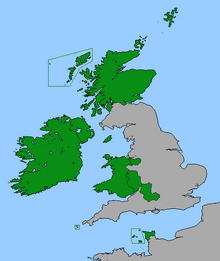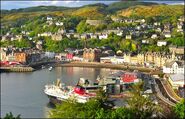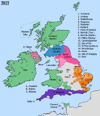Céad Míle Fáilte! (Irish Gaelic) ("A Hundred Thousand Welcomes!") | |||||||
| Capital | Dublin | ||||||
| Largest city | Dublin | ||||||
| Other cities | Armagh, Cork, Cherbourg, Conway, Douglas, Derry, Fishguard, Inverness, Galway, Glasgow ,Oban, Quimper, Rennes, Stornoway, Liverpool, New London, Nates | ||||||
| Language official |
Irish & Scottish Gaelic, English, Breton, French. | ||||||
| others | Welsh, Manx, lowland Scots, Oïl languages, Cornish, Norman. | ||||||
| President | Mary Robinson | ||||||
| Prime Minister | Andrew Price | ||||||
| Area | 267,000 km² | ||||||
| Population | 5,500,000 | ||||||
| Independence | 20th, March, 1986 | ||||||
| Currency | Cel | ||||||
The Celtic Alliance, officially the Alliance of the Celtic Peoples is a parliamentary-federal republic situated in Western Europe. The political state was formed as a result of survivor nations surrounding the Irish Sea joining together after Doomsday to form a single political state (while still preserving a great deal of national autonomy for its member nations). Following the nuclear destruction across France and the United Kingdom, Eire was one of the most powerful and stable state in Western Europe. After the first few years of securing its own survival Eire would then go on to help stabilize the surrounding nations and bring them under normalized control.
Eventually this alliance between Eire and the surrounding nations would be strengthened and a single united federal republic was formed.
The political state was founded on the ideals of social democracy, federalism, civic republicanism, Pan-Celticism as well as Celtic revival. Today the republic is one of the strongest political states in military and economic terms left in Europe and to a certain extent the world and is a leading member of the Euro-Atlantic Fringe, along with the Nordic Union. It is also a secular state.
Founding nations of the Celtic Alliance
Eire (Ireland)
The capital city of Eire (Ireland) and of the Celtic Alliance as a whole, is the city of Dublin.
It is formed from the Irish Republic counties of Wicklow, Wexford, Carlow, Kildare, Meath, Louth, Monaghan, Cavan, Longford, Westmeath, Offaly, Laois, Kilkenny, Waterford, Cork, Kerry, Limerick, Tipperary, Clare, Galway, Mayo, Roscommon, Sligo, Leitrim and Donegal.
Also included are the counties of the former British Northern Ireland (or Ulster) namely Antrim, Armagh, Down, Fermanagh, Londonderry and Tyrone.
Although Belfast (the capital of Ulster) was hit on DD the other towns and cities in Ulster and the Republic of Ireland survived relatively unscathed.
Mainland Scotland
The capital is Glasgow. It is formed from the former Scottish counties of Dumfrieshire, Perthshire, Invernessshire, Ayrshire, Caithness and Sutherland, Ross, Moray, Angus, Aberdeenshire, Argyll, and small areas of neighbouring counties.
Areas around the towns of Ayr and Dumfries were taken into the Celtic Alliance after the defeat of Ur Alba in the Ur Alba War.
Outer Hebrides
It is formed from the Islands of Lewis (where the capital of Stonoway is located), Harris, North Uist, South Uist, Benbecula, Barra, Scalpay, Brenera, and Grimsay.
Inner Hebrides
It is formed from the Isle of Skye (where the capital of Portree is located) and the surrounding islands of Jura, Mull, Raasay, Arran, Ilsay, Tiree and Colonsay, along with the small isles of Rum, Eigg, Canna, and Muck.
Northern Isles
It is formed from the island groups of Shetland and Orkney, where the capital of Kirkwall is located.
Other nations in the Celtic Alliance
Wales
The Celtic Alliance welcomed the whole of Wales into the Alliance in 2002.
It is formed from the former Welsh counties of Powys, Pembrokeshire, Gwyneed, Anglesey, Conway, Snowdonia, Ceredigion, Denbighshire, the Valleys, Monmouthshire, Glamorgan, Neath, the Gower, Carmarthanshire, Bridgend, and Flintshire.
When Welsh counties joined the Celtic Alliance
- Anglesey, Conway, Snowdonia, and Ceredigion joined in 1995.
- Denbighshire, Flintshire, Pembrokeshire, Carmarthanshire and the Gower joined in 1997
- The Valleys, Monmouthshire, Glamorgan, Neath and Bridgend joined in 1999.
- Powys joined in 2002.
The official capital is Aberystwyth in Ceredigion.
England
Formed from the former English counties of Cornwall, Devon, Dorset, Wiltshire, Gloucestershire, Somerset, Herefordshire, Shropshire, Merseyside, Oxfordshire, Berkshire (where New London is located), Worchestershire, along with western parts of Cheshire, and Southern Buckinghamshire.
The official capital is Liverpool in Merseyside.
When English Counties officially joined the Celtic Alliance
- Cornwall and Devon joined the Celtic Alliance in 1994.
- Merseyside (Liverpool) and western Cheshire officially joined in 1995.
- Somerset, Gloucestershire, Dorset and Wiltshire joined the Celtic Alliance in 1997.
- Hertfordshire, Shropshire, and Worchestershire officially joined in 2000.
- Oxfordshire, Berkshire (New London) and southern Buckinghamshire officially joined in 2002.
Celtic Alliance territories in the former UK are divided into three sections:
- Devon and Cornwall - Have their own Regional Assembly.
- North West - Includes Merseyside, Western Cheshire, Herefordshire, Shropshire and Worchestershire.
- Wessex - Includes Somerset, Gloucestershire, Dorset, Wiltshire, Oxfordshire, Berkshire and southern Buckinghamshire.
Angel Isles
- The Channel Islands (Jersey, Guernsey, Alderney, Sark and Herm) Joined in 1993.
- The Isles of Scilly (St Mary's, Tresco, St Martins, St Agnes, Bryher and Samson) Joined in 1994.
- The Isle of Man (Manx and the Calf of Man). Joined in 1994.
Captial city is Douglas on Manx.
Brittany and Lower Normandy
Formerly part of the pre-Doomsday nation of France, the area around Brittany has always been culturally different from the rest of France often referred to by the French as Little or Small Britain as opposed to the UK known as Great Britain. This is mainly due to the fact that the area was settled by refugees from Great Britain after the conquest of the island by the Anglo-Saxons in the fifth to seventh century AD.
The Brittany locals speak both French and native Breton, a Celtic language related to Welsh and Cornish.
The locals of Lower Normandy speak French and Norman, a version of French based on old Frankish, a language formally spoken throughout northern France, the Netherlands, Belgium and Western Germany.
Brittany became part of the Celtic Alliance in 1993.
Lower Normandy became part of the Celtic Alliance in 1995.
In 2009, the Celtic Alliance formalised its boundaries in the north of former France using the main rivers. To the south the River Loire and to the east the River Sarthe (tributary of the Loire), the River Eure (tributary of the River Sienne) and then the border follows the River Seine to the English Channel.
History
Targets
The immediate effects of Doomsday has been the complete and utter destruction of the centres of population of the former British mainland especially the heavily populated areas of England, central Scotland and Wales with an additional missile attacks on the city of Belfast (the only target on the island of Ireland) in Northern Ireland, with initial deaths nearing 40 million.
Post-Doomsday
The government of the Irish Republic declared immediate martial law and initiated emergency procedures for the anticipated massive thermonuclear attack. This direct attack on the Republic never happened as the Soviet Union saw no threat coming from the Irish state, which had on occasion been a critic of NATO and the U.K. Nevertheless, with the attack on Belfast and the UK government having been perceived to have been wiped out, the Republic and Northern Ireland Counties agreed to combine their efforts to restore order and acted to assist refugees and the masses of injured in the greater Belfast area. Within several days it became clear that radiation clouds would be the greatest threat to Ireland's long term survival, and for the next few weeks arctic winds drove the radiation across western Europe eastwards saving many lives in Ireland.
It was also clear by the 1st week that all communication with the main centres of the United Kingdom, the rest of the European Economic Community (EEC) and other nations had been lost.
Steps were taken to ration food, medical and fuel supplies. This was done with minimal civil disorder by bringing local communities together in communes to enable to supply of goods to those most in need. Two months after the war, a message was issued stating that people must concentrate their energies on agricultural production in order to remain alive.
The Church became a useful tool in maintaining communication across the country. Nevertheless, the state in its first emergency meeting surprisingly disestablished its historical links with the Roman Catholic Church to ensure full freedom of religion in the North.
4 weeks after DD, initial contact was made with the Isle of Lewis on the western fringe of Scotland. Communication was via morse code, instructing the Irish republic that several Scottish Members of the UK Parliament had been on a development meeting during the strike. The 5 members were all members of the Scottish National Party (pro-Scottish independence) even though, as their leader was a Privy Councillor, they were in fact the de facto government of the UK as all other MP had been at Parliament during the attack on Doomsday, including MP’s from Northern Ireland.
Military personnel or Óglaigh na h-Eireann were dispatched to review the situation on Lewis and returned with the MP’s.
Death and breakdown

1984 BBC docudrama on nuclear war and its effects (pt10of13)
Impact and outcome Sheffield
Initial visual documentary evidence from military sources of the impact of Doomsday was sourced from military archives this disturbing evidence has been shown across the Alliance.
Sporadic reports from emergency operation centres (EOC) across the British isles indicate high yield thermonuclear warheads have exploded across the majority of the UK. Initial deaths estimated at 40 million. What is left of the UK government structure at local level instigate the "Emergency Powers Act". "If at any time it appears to Her Majesty that any action has been taken or is immediately threatened by any persons or body of persons of such a nature and on so extensive a scale as to be calculated, by interfering with the supply and distribution of food, water, fuel, or light, or with the means of locomotion, to deprive the community, or any substantial portion of the community, of the essentials of life, Her Majesty may, by proclamation (hereinafter referred to as a proclamation of emergency), declare that a state of emergency exists"
It would seem that the population has or will fall to a minimum of 11 million. Authorities state that no efforts are made to bury the dead as the majority of the surviving population is too weak for physical labour. Burning the bodies is considered a waste of what little fuel remains, as is using fuel to power bulldozers in order to dig mass graves. Millions of bodies are left unburied throughout the UK, which leads to the outbreak of diseases such as cholera and typhus.
Initial reports across Ireland estimate that the first strike against Belfast had killed in excess of 550,000 people with casualties in the region of over 100,000. Refugees heading south and west to the republic number in excess of 200,000. The early UK death estimates can only be guessed at around 40 million. The population of the Scottish Islands stands at 60,000 with the provisional capital being designated as Stornaway on the Isle of Lewis.
In addition, casualties from radiation fall out and long term sickness have added considerable burden to the formative years of the Alliance. Each county or burgh reported continued and increasing deaths from radiation with the population of Ireland alone falling from 3.5 million to just over 2.5 million through sickness and starvation.
Belfast as the main target on the island has seen the greatest destruction. The city was wiped of the map with huge numbers of casualties, nevertheless, like many cities and towns in the western UK notably in northern Ireland and Scotland the hilly geography reduced the over all impact on the wider countryside. This allowed large numbers of those in the suburbs of Belfast to escape, it also believed that large numbers in the periphery of the city of Glasgow due to its geography may have escaped though it was a prime target for over three missiles, there is still doubt if all three reached their target due to the number of refugees from Glasgow reaching the Islands. Glasgow was the third largest UK city and close to nuclear military facilities on the River Clyde. Consideration is being given to mounting an expedition to Glasgow when radiation levels drop to a palatable level.
Birth of a Celtic Alliance
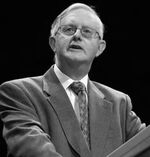
Gordon Wilson M.P.
The Irish government after talks with the northern counties and remaining UK MP’s agreed to formal alliance to ensure effective democratic government of the remaining populated areas, though still claiming rights over the rest of the U.K. The formal alliance was signed by the Irish President Patrick J Hillery, Mayors of the Northern Irish Counties and Gordon Wilson (SNP) MP Privy Councillor of the UK, formally establishing the Celtic Alliance as a democratic successor state to the United Kingdom of Great Britain and Northern Ireland and the Republic of Ireland (Eire). This was signed on the 20th March 1986 on the spring equinox symbolizing Celtic rebirth and renewal.
The government has suffered many set backs in its initial attempts to provide basic food and supplies for the general population, yet there has been little civil unrest. The population seemed fully aware of the monumental task facing the country as well as the alternative to government action being anarchy. The principle concerns relate to contaminated supplies and the militaries ability to maintain supplies across the new alliance.
Limited local elections are held to appoint mayors (Ireland) and provosts (Scottish Islands) to the main areas of population to enable some form of government and legal representation in each area. The Catholic and Protestant churches in both Ireland and Scotland unify to ensure community cohesion. Most of the Northern Irish Protestants stayed out of this union (The majority of Scots, or what is left have rejected this idea and have embraced the Alliance governance project), and since the late 1980's over 90% of them have left for the Realm of New Britain, tempted to emigrate by generous land grants under the Whitelaw government, as well as the cleaner air and healthier lifestyle and their continuing loyalty to King Andrew. Many Northern Irish Protestants found that on arrival in New Britain that life was harsh and was fettered with the legacy of colonial rule. Evolving calls for a more indigenous South Africa are causing many to reconsider their allegiance to the British Crown, which in reality fled the U.K. leaving the nation and its survivors to fend for themselves, the monarchy is a non-issue to the Alliance population.
Since 1993 the President of the Alliance has been the former lawyer Mary Robinson and the Taoiseach (Prime Minister) was Andrew Welsh a former Scottish Nationalist MP. Andrew Welsh retired in 1999, the present Taoiseach is Adam Price who won a landslide victory in 2009.
The initial provisional Alliance government from 1984 to 1986 was based on the Irish Republic model (as the Republic had the largest population numbers this was seen as only fair by the other participants. Nevertheless, in 1986 new elections to a new Parliament were held with smaller numbers of MP's. Each MP is also the county Mayors of Ireland and Island Provosts from Scotland, Manx or the Isle of Mann though still having a provincial parliament appoints a commissioner to represent it in Dublin as does the Channel Islands. recent additions include Mayors from England, Channel Isles, Brittany and Normandy
The Rest of the Decade
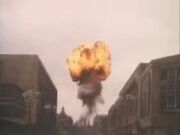
Belfast on the day of attack
Further contact was established with the remnants of some Scottish western Islands as well as Orkney and Shetland, in addition EOC's have continued to relay information from various parts of the U.K, though EOC's are few and far between due to the surprise attack. In addition small expedition forces on the fringes of the toxic UK mainland noted utter devastation and the complete breakdown of the rule of law. The western Scottish Islands began to form militia and with the assistance of the government in Dublin who agreed to military posts to protect the islands from sporadic raids by marauders from the mainland. In addition landings were made in Oban to build a refugee 1st stage camp. The camps role is to co-ordinate the relief effort and ensure that those in dire need of medical attention receive at least basic pain relief as well as enabling healthy survivors to reach the Islands
Initial radiation patterns have reduced contact with the rest of the world to zero, with the Alliance considering that the majority of the globe having entered a period of complete social meltdown. The government maintains martial law and initiates the fuel and food laws to maintain supplies to agriculture and food production; formal discussions at government level begin lay the principle agreements for the Celtic Alliance. Mass starvation is still a great worry, though vast swathes of land have been turned over to food production even public parks and areas on the seashore. The Scottish Islands come under further stress by the influx of refugees from the greater Glasgow area especially from the north of the city. The refugees tell of mass death and destruction with marauding hordes across what is left. There are reports of cannibalism and emerging feuds as well as mutated births. Radiation sickness is the main killer in the Alliance
Initial aerial reconnaissance over Liverpool and Glasgow found fortified groups of survivors in encampments in each city, contact has been limited to food and medical supply drops in the Liverpool area. Radio contact has been made with Glasgow, numbers of survivors is now estimated to be in the thousands. Due to the high levels of radiation in eastern Scotland and southern England the use of drones has been limited.
Fuel: Due to Scotland’s high oil reserves small oil platforms on its western fringes have been put into full production. Though smaller than those in the North Sea, which were destroyed they nonetheless are helping greatly in maintaining basic supplies to what is left of the population. Nevertheless, draconian laws have limited the use to purely agricultural, military and medical use
Food: Given Ireland and Scotland’s histories with famine, it has been of no surprise to the population for the need to cut back on food consumption. All arable land has been turned to cultivation of diverse crops with a marked reduction in meat production. Further to this the western fringes of Ireland and Scotland have once again become havens for the re-emerging fishing industry though much of the waters are heavily polluted. Nevertheless, food production is limited and the general population has become increasingly concerned about the raise in cases of starvation in the main centres of population. Fish production is stepped up as is the usage of the humble potato.
Food policy 1983 - 1995: Those who work get more food than those who don't and the more people die, the more food there is for the rest.
The Celtic Alliance is formally constituted during the spring equinox of 1986 on the 20th March (Using traditional timings the government hope to maintain some notion of history for the new nation) bringing to an end the UK founded in 1707 and the Irish Republic declared in 1922, yet strangely it brings back under one nation the Isle of Ireland and Scotland as was under the old Celtic Kingdom of Dalriada. Nevertheless, the new Alliance also claims sovereignty over the UK and dependencies with legitimation from the former UK MP's, and it is hoped to re-establish some form of legitimate government in the future on the rest of the British Islands. The last two years have seen profound change in the Isle of Ireland, Scottish Islands, Isle of Man and Channel Islands with starvation and death on a biblical scale. Nevertheless, in a interesting twist just like the Celts of the dark ages, they have used their Celtic ingenuity and a their ability to invent to develop structures which have maintained the structure of government and ensuring that entire communities work to restore some vestige of civilization to the European fringe. The onset of the nuclear winter is not as bad as many predicted but the nuclear summer is a profound awakening for the usually cloudy nation. The population work the fields either in the early morning or late evening and if needed cover completely to work during the day. A major boost to the population is the maintenance of the primary education system, enabling parents and carers to work in the production of food as well as maintaining an educated workforce for the future.
It becomes clear that the three missiles that targeted Glasgow did not all reach their target, with one missile reaching the nuclear base on the river Clyde, the western fringes of the city and towns notably Greenock, Clydebank and Dumbarton receive heavy damage. Nevertheless, the majority of the city remains intact. Contact with Dublin is restored and long supply lines are started via Oban as the lower Clyde is contaminated. Glasgow formally appoints a new Senator Provost (as opposed to OTL Lord Provost) who will sit in the Dublin Parliament. The Senator Provost is Jim Sillers a well known trade unionist and Scottish Nationalist.
1992 -1993- First Contact
21st January 1992 a ham radio signal is received from the Azores re-establishing contact with the outside world.
October 1st, 1993 The new Celtic Alliance government formally welcomes the Nimitz to Galway the port city of the Alliance. Bringing much relief to the beleaguered government and hard pressed population. Discussions begin in Canberra about the legal right of British dependencies and former colonies with the New Celtic Alliance. The Alliance though in no way wishing to become a global power asks for time to deliberate on the impact of giving up sovereignty on the populations so socially and historically connected to the old UK especially the Falkland Islands & Gibraltar. The remainder of the U.K. naval operations in the Island are transferred back to Galway with several naval ships notably HMS Hermes making its way to the Alliance after spending time under ANZC command. The Alliance asks for plebiscites in each area dependency and seeks to maintain a neutral role hoping most colonies will choose new alliances or strike out on their own.
Former U.K. diplomats in ANZC become the official voice of the new Alliance at the League of Nations discussions, nevertheless, the Alliance feels compelled to replace the British & Irish Ambassadors who died in the initial attacks on Australia as soon as possible with a new appointment; a prominent former Scottish Nationalist Alex Salmond is appointed. Further contact is established with Brazil and Australia. Formal relations are agreed upon and the Nimitz returns to Australia with the Alliance's 1st ambassador.
Welsh Periphery
Recovery missions across the Welsh coast in the early 1990's identified large numbers of survivors. The majority coming from the coast, notably Pembrokeshire, Anglesey, Conway, and Ceredigion.
The whole of Wales became part of the Celtic Alliance in 2002.
Southern England
From the early 1990's Celtic Alliance medical teams continue to investigate areas around London and the counties of Kent and Sussex establishing medical bases and strategic commands to enable better delivery of food and supplies.
Initial population estimates range between 200,000 to 600,000 with law and order being a major problem particularly in Kent. Armed militia continue to harass medical services, though local designated police forces are starting to gain the upper hand over lawlessness. The appointed head of the interim County and appointed interim M.P.is Paul Carter.
In 1992 the Celtic Alliance assisted the newly formed Confederation of Wight and Hastings in the removal of a dictatorship from the town of Worthing in West Sussex.
At Christmas 1992 the Confederation was dissolved and the Federal Republic of the Isle of Wight and Sussex (or Southern England) is formed.
From the year 2001 the reliance of the Republic on the Celtic Alliance slowly ebbed away as the nation grew and became self reliant.
From 2005 the majority of Celtic Alliance troops had been withdrawn leaving only medical personnel and engineers, as Celtic trained Republic troops and police forces took over the law and order of the Republic.
1993 - A shipping nation again
Galway becomes the principle staging post for missions to mainland Europe as well as the main ship building port of the alliance, many survivors from both Belfast and Glasgow the great shipping cities play a major part in rebuilding the alliances communication via shipping along its coast lines (in a twist of fate this was why the ancient celtic kingdoms where often called the sea kingdoms). Nevertheless, due to lack of supplies most of the limited numbers of ships are built from recycled materials and are used primarily to maintain contact between the main centres of population. It will take another 20 years before the Alliance in conjunction with the Nordic Alliance agree the terms of a European Navy that will assist the European states to reach further into mainland Europe with the necessary supplies for relief.
Life Choices - 1993
Substantial losses in life continue to effect the recovery of the new alliance, though population numbers stabilize around 2m. The state passes the "Abortion (Eire) Act" 1993 to deal with the amount of births with profound deformities caused by radiation and pollution, the act is contested in the supreme court by religious groups and liberal pro-lifers who due to the war now defend human life at all costs but passes in to law making abortion legal in Ireland for the 1st time.
Liver bird takes flight
After the initial contact with Liverpool in 1995, the Alliance continues to send supplies to the main settlement in Birkenhead. The main sections of the city have been hit by a high yield atomic bomb on its northern edge, this has allowed refugees to pour over the River Mersey to Birkinhead.
In the October of 1995 the city is formally reconstituted with its temporary HQ being based in Birkenhead, the authorities assume the Liver Bird symbol which sits atop the Liver Building on Liverpool's waterfront as the city's new symbol. The 1st election to the Parliament in Dublin takes place on Thursday November 2nd, the hotly contested election is won by Paul O'Grady a Drag Queen known as Lilly Savage, he wins by a landslide on a ticket of anti-corruption, human rights and good financial management. Mayor O'Grady MP also has a keen interest in agriculture and sets about diversifying the local economy based on local produce and fishing.
When the first democratic elections took place Merseyside and western Cheshire joined the Celtic Alliance.
The population of the city stands at 12.000, with over 708,000 known to have perished through the initial blast and subsequent radiation sickness and starvation
Yorkshire Coast
- Main article: Kingdom of Cleveland
During a fishing trip from off the east coast of Yorkshire in 1997 a small Celtic Alliance trawler comes across a cobble (small open fishing boat) longline fishing.
The two crews make contact and the Scots discover that the two Atomic bombs aimed at the Tees Valley missed one hitting 7 miles north east of the intended target, off the coast of Hartlepool, the other 12 miles south of the target over the North Yorkshire Moors. The towns in the Tees Valley were exposed to large radioactive fallout blown inland by the prevailing winds causing many tens of thousands of deaths. One survivor of note is Princess Anne (only daughter of the former Queen Elizabeth II)
The Kingdom of Cleveland is due to vote on a referendum on becoming part of the Celtic Alliance on 21st May 2010. However popular opinion is that the Kingdom of Cleveland will remain independent.
28th May 2010
At 10am the results of the referendum on the Kingdom of Cleveland joining the Celtic Alliance. The vote was as follows:
- Yes - 17%
- No - 83%
the voter turn out was 78%.
Prime Minster Mallon makes a statement at 11am, that the people of Cleveland had spoken, but just because the vote had been no, that trade relations were just as good as before the referendum.
In early 2010 the governments of the Kingdoms of Cleveland and Northumbria approached the Celtic Alliance with the possibility of linking the countries by a rail line.
The line currently travels north from the former county of Yorkshire and stops at Berwick upon Tweed but surveys north along the line show that the Forth Bridge is still relatively intact and with some repairs will be possible, the main problem is with putting a rail line through the heavily irradiated remains of Edinburgh. However the Kingdoms have experience of building lines through irradiated areas having put a line through the bombed out remains of the Tyne and Wears valleys in the mid 2000's.On the 29th March 2010 five engineers working on the former east coast mainline are killed by a derailment caused by a landslide across the tracks just north of Berwick. Ongoing repairs should mean that the line will between Berwick and Glasgow in late 2010, and between Berwick and Fife (across the Forth Rail Bridge) sometime in late 2011.
The first train linking the Kingdoms of Cleveland and Northumbria with the Celtic Alliance in Glasgow arrives in Glasgow main rail station on the 13th November 2010.
New London
New London was founded in 1987 in the former Royal Borough of Windsor and Maidenhead in Berkshire. The Mayor is a former civil rights worker Diane Abbot.
New London became part of the Celtic Alliance in 2002.
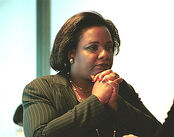
Mayor Diane Abbot of New London
In addition to medical supplies and militia development in the south east, commanders have sought to rebuild connection to the communities near the obliterated landmass of London.
Initial research has identified various communities even in the outskirts the city, though there are large areas of radiation. Due to limited medical supplies in the immediate aftermath of DD radiation related illness is a major and debilitating factor of life for many. In addition, only now are the majority of births not affected by dreadful debilitating conditions and deformities.
The Alliance government issues the following declaration to retain political control of the south east.
“In so much as this Alliance is the heir of the former Irish and British States and is imbued with their powers and rights, we the people restate our right and duty to maintain the freedom, liberty, community, security and dignity of these Islands by appointing the Interim Mayor of the City of London, with all the powers that this Parliament sees fit to retain the said rights of the Alliance and maintain the dignity of the people.”
The first elections in New London took place in 2000 with Interim Mayor Diane Abbott winning with 68% of the vote she was proclaimed Mayor on the 23rd October 2000.
The New Millennium
In 2004, the Parliament in conjunction with the WRCB begins the formal count of survivors inside contaminated areas, in addition to initial contact over the last 10 years medical staging points are bolstered by supplies from ANZ. Highest levels of radiation are being measured in Greater London, Manchester, Portsmouth, Southampton, Plymouth, and Birmingham.
Medical staging points: MSP's have been in operation since 1987, with the first being placed in Oban. They have proved useful in restoring contact with communities and individuals as well as offering medical and food supplies to contaminated areas.
As well as providing medical aid MSP's offer the opportunity for life ending, via ECC's (End Cycle Centres), these centres offer a pain free method of euthanasia. Highly contentious, these centres are often only to be found at the outlying MSP's and never near the main centres of population. The church and a vocal minority are opposed to the centres with early centres being destroyed in civil disorder.
In 2007, the Atlantic Defense Community is founded, which is constituted of what remains of the old NATO powers commit to cooperating militarily in the present and future. The Atlantic Defense Community is established. It includes what is now Spain, Portugal, the Celtic Alliance, the Nordic Union, and Canada. The Alliance appoint LT GEN D EARLEY as the Alliances Command representative based in the Azores.
2009 General Election
In 2009, the incumbent Taoiseach Mark Cosgrove tries to hold together the Dalriadic Party in the face of a political fall out with the Kingdom of Cleveland and the pressure of the new left of centre Celtic Democratic Bloc. Its leader Adam Price is social progressive making huge strides in the heartlands of the Daldriadic Party notably Scottish Islands, Armagh and the Welsh districts. The Bloc is denouncing the old political elite and demands changes to the constitution for devolution to the Alliance members given the huge international political changes sine DD.
The Bloc is leading in all polls and is in position to be the largest party in the Dublin Parliament, though it will have to form a coalition
Medicine Impact
Long held as centre for medical excellence the Alliance is once again at the forefront of medical advances in treating radiation sickness and other ailments brought on by the aftermath of Doomsday. The Alliance is formally asked by the LofN's to house the Medical wing of the LofN's. this is opened by the Secretary General in November 2008. The positioning of the medical wing is also based on the Alliances proximity to mainland Europe and also its distance from the Sicilian Republic.
The LoN Mediwing is the directing and coordinating authority for health within the LoN's system. It is responsible for providing leadership on global health matters, shaping the health research agenda, setting norms and standards, articulating evidence-based policy options, providing technical and practical support to countries and monitoring and assessing health trends.
In the 21st century, health is a shared responsibility, involving equitable access to essential care and collective defence against transnational threats.
The Constitution and Political Framework
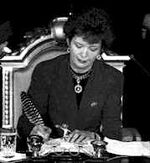
President Mary Robinson signing the new constitution
The 2009 Constitution is the principle document up on which all future law and principles of democratic government are to be based on. the document takes its foundation from the great political documents of human history especially, the United Nations Charter, Irish Constitution, Magna Carta 1215 and the Declaration of Arbroath of 1314. The Alliances democracy is founded on eight pillars, independent judiciary, personal freedom, dignity, self determination, the rule of law, the right of association, freely elected government and universal suffrage.
Preamble to the Constitution: Let it be known, that if our government should give up what we have begun, and agree to make us or our Alliance subject to any other, we should exert ourselves at once to drive out our government as our enemy and a subverter of their own rights and ours, and make another government who was well able to defend us and our constitution; for, as long as but a hundred of us remain alive, never will we on any conditions be brought under the rule of tyranny. It is in truth not for glory, nor riches, nor honours that we lay down this constitution, but for freedom -- for that alone, which no honest person gives up but with life itself.
- Main article: Constitution of the Celtic Alliance
- Main article: Government of the Celtic Alliance
- Main article: Political Parties of the Celtic Alliance
Divisions
The present Parliament or Oireachtas sits in Dublin with 77 MPs
| Nation | Capital | County / Burgh | Seats in Parliament |
|---|---|---|---|
| Eire Isle of Ireland |
Dublin | Dublin, Wicklow, Wexford, Carlow, Kildare, Meath, Louth, Monaghan, Cavan, Longford, Westmeath, Offaly, Laois, Kilkenny, Waterford, Cork, Kerry, Limerick, Tipperary, Clare, Galway, Mayo, Roscommon, Sligo, Leitrim, Donegal, Antrim, Fermanagh, Tyrone, Derry, Down, Armagh, | 32 |
| Alba Mainland Scotland |
Glasgow | Glasgow, Dumfrieshire, Perthshire, Inverneshire, Ayrshire, Caithness and Sutherland, Ross, Moray, Angus and Aberdeenshire, Argyll. | 10 |
| England England |
Liverpool | Cornwall, Devon, Dorset, Wiltshire, Gloucestershire, Somerset, Herefordshire, Shropshire, Merseyside, Oxfordshire, Berkshire, Worchestershire, along with western parts of Cheshire and Southern Buckinghamshire. | 9 |
| Gorllewin Cymru Wales |
Aberystwyth | Powys, Pembrokeshire, Gwyneed, Anglesey, Conway, Ceredigion, Denbighshire, The Valleys, Monmouthshire, Snowdonia, Bridgend, Glamorgan, Neath, The Gower, Carmarthanshire and Flintshire. | 7 |
| Na h-Eileanan a-staigh Inner Hebrides |
Portree | Skye, Islay and Jura, Mull, Arran, Small Isles (Rum, Eigg, Muck, Canna, Sanday) | 5 |
| Na h-Eileanan Siar Outer Hebrides |
Stornoway | Lewis and Harris, North Uist, South Uist and Benbecula | 3 |
| Arcaibh a-Zetland Northern Isles |
Kirkwall | Greater Orkney (East and West Mainland, Ronaldsay, and Hoy), Lesser Orkney (Sanday, Stonsay, Westray, Eday, Rousay, and Shapinsay), Shetland, | 3 |
| The Angel Isles Manx, Isles of Scilly and the Channel Islands |
Douglas | Manx, Scilly, Channel | 3 |
| Bertaèyn et Basse-Normandie Brittany and Lower Normandy |
Nantes | Owened, Saint Brieuc, Saint Naziaire, Kernev, Le Mont-Saint-Michel, Cherbourg, Quimper, Rennes, Caen, Bayeux, Saint Malo, | 5 |
After Doomsday, the party political structure changed completely with the Scottish National Party (SNP) and the former Ulster Unionist Party (UUP) and the Democratic Unionist Party (DUP) merging to form a northern block called the Dalriadic Party (From Kingdom of Dalriada, former Celtic kingdom crossing northern Ireland, Donegal and western Scotland circa 8th Century) to ensure adequate representation for Donegal, the Ulster counties and Scottish Islands. In recent years emerging political alliances have emerged between pro-devolution supporters bringing about the Celtic Democratic Bloc
Culture
- See also: Celtic Church
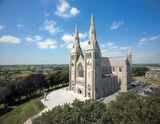
Armagh Cathedral
Celtic Congress Fringe meeting 2007
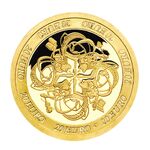
Cel
Most people living in the Celtic Alliance are united by a shared Celtic history and culture, although the nations still retain the unique national identities. Although united as a single political state most people from Ireland are still identity themselves Irish first and Celtic second, and the same could be said for the other nationalities. Still, the Celts maintain a friendly bond between each other which has only strengthened since doomsday. The state encourages the use of a Celtic identity, although it also protects the lesser nationalities. Several pre-existing Celtic organisations such as the Celtic League or the Celtic Congress have been officially nationalized by the government.
The Celtic Alliance also promotes increased use of the once endangered Celtic languages. With the destruction of several urban centers and the use of the languages in isolated areas, the proportion of Gaelic and Celtic speakers to the general population has greatly increased. This combined with increased education means that these languages are ever increasing in both speakers and importance. Nevertheless English is still the most widely used and understood language. French on the other hand has declined, and most of the younger Bretons now speak either English or Breton.
Despite the ever present Celtic influence throughout the state there remain several areas that do not share this identity. The people of Channel Islands, the Cherbourg Peninsula (Normandy) and the English parts of the country are non-Celtic, and remain culturally isolated from the rest of the country. Although the far northern coast of Cornwall is both Celtic and within the Alliances sphere on influence, the population here remains extremely low thanks to the nuclear attacks in the area. There has been talks of independence in these areas from the rest of the country, although given their critical dependence on the rest of the Alliance this remains very unlikely for the time being.
National Anthem
In order to return the nation to a normal footing the government agrees to a request for song contest based on the former Eurovision model. The aim of the contest is to restore the tradition of singing and oral history as well as giving the emerging nation some light relief. In addition the contest will pick three anthems National Anthem of the Celtic Alliance, Official Anthem of Parliament and the Official Presidential Anthem.

You'll Never Walk Alone-BARBRA STREISAND
You will never walk alone anthem of the Celtic Alliance

Barbara Dickson - Caravans
2nd Place in anthem contest

Enya - May It Be (Live at Academy Awards 2002)
3rd Place and Winner of the Presidential Anthem
There was a surprise National Anthem entrant – Barbra Streisand! Former American citizen who was on holiday in Ireland during Doomsday comes forward with surprise entry of the Carousel musical hit of the 1960’s “You’ll Never Walk Alone”. Mass demonstrations in support across the Alliance after a deeply moving and personal stage performance paying tribute to all of the fallen especially those she left behind in the former U.S.A. All other entries have withdrawn from the competition and throw their weight behind Streisand.
In a statement the president said after the show,
'I am moved beyond comprehension, each emotion we have collectively held since 1983 has poured forth like a torrent since hearing Barbra. I am in no doubt that the people have their new National Bard as well as a new anthem. The music speaks for itself’
Speaking after the show, Ms Streisand has said:
' All I could do since 1984 was cry, today I stopped crying. It was all so emotional I only hope that people liked the song and what it means for the Alliance which has done so much for me since 1983. This is for them'
Contestants of the National Anthem Symposium Alliance Theatre Dublin 26th June 2009:
In running order –
Runrig – Protect and Survive Blue Nile - Tinseltown in The Rain
The Shop Assistants - Safety Net
Barbara Dickson - Caravan
Sweet Savage - Straight Through The Heart
Christy Moore – Ordinary man
Kate Bush - The Dreaming
Enya – May it Be
U2 – Under a Blood Red Sky
Sheena Easton – The Arms of Orion
Barbra Streisand – You’ll Never Walk Alone
Top Three:
Winner By Acclaim Barbra Streisand – You’ll Never Walk Alone - National Anthem of the Celtic Alliance
2nd Barbara Dickson – Caravan - Winner of the Freedom Award - Official Anthem of Parliament
3rd Enya – May it Be - Winner of the Presidential Anthem Award - Official Presidential Anthem
Economy
The economy of the Celtic Alliance is one of the largest in the world. It is based around many things, mainly exports such as ore mining, zinc, natural gas, sale of pharmaceuticals and other medical goods and agriculture. Most of Europe relies on the Celts for medical goods and the poorer communities food. Aviation materials are also a minor factor of the economy. The Celtic Alliance is the leader of Europe's latest military technology.
Military
- See main article: Military of the Celtic Alliance
Sports
Within former Ireland, Gaelic games (Gaelic football, hurling, rounders and camogie) are the most popular, followed by association football (soccer), rugby union, cricket and boxing.
The Gaelic Athletic Association is the official sanctioning and overseeing body over the four Gaelic games throughout the Celtic Alliance.
Within the portions of the country formerly part of the United Kingdom and France, association football is by far the most popular sport, with many of the national side players coming from the portions of former England, Scotland, Wales and France controlled by the Celtic Alliance.
There is a three-tiered association football pyramid in the Celtic Alliance. The Celtic First Division and Second Division are the top two flights and include the following clubs:
- Bohemians
- Bray Wanderers
- FC Brittany
- Celtic
- Cork City
- Derry City
- Drogheda United
- Dundalk
- Galway United
- Heart of Midlothian
- Hibernian
- Liverpool FC
- New London FC
- Normandy FC
- Rangers
- St Patrick's Athletic
- St Johnstone's
- Shamrock Rovers
- Sligo
- Stromness FC
- FC Wales
There is discussion among some fans and officials of reviving some or all of the London-based pre-Doomsday football clubs. Aside from the issue of a lack of a population base to support all (or most) of them, Celtic football officials also have cited a desire for a "new" football club for residents of the rebuilt London to support.
Other popular sports, as they were in the former UK, are rugby union and cricket.
Rugby league had disappeared post-Doomsday, but there is a small national federation attempting to spark interest in that sport once more. Gaelic games have virtually no following outside former Ireland, although the GAA continues to attempt to establish them among the youth.
Golf has made a comeback of sorts in recent years, particularly as the famous St Andrews Golf Course was salvaged and restored in 2008.
International Relations
The Celtic Alliance is a member of the League of Nations and the Atlantic Defense Community.
They have close relations with many OBN nations particularly Kingdoms of Northumbria and Cleveland as well as Southern England.
Between the 23rd April and the 8th May 2011, the Celtic Alliance, along with the allied nations of Southern England and the Kingdoms of Cleveland and Northumbria were at war with the nation of Ur Alba.
During the The Ur Alba War the Celtic Alliance lost 832 military personnel. After the war, and the collapse of the nation of Ur Alba, the Celtic Alliance claimed lands conquered by Ur Alba in the past two years. The Celtic Alliance gets the entire Irish Sea coastline of the former nation of Ur Alba, from Glasgow to the border with the Kingdom of Northumbria and as far inland as the former A76 road.
As part of the peace deal the Celtic Alliance, along with the other allied nations helped set up a provisional government for the newly created nation of Southern Scotland. The Celtic Alliance had four seats (of fourteen governmental seats) on the provisional government, they helped rule the area until free, fair and democratic elections were held in the area in October 2011.
Currently the Celtic Alliance has borders with:
- Northumbria in a very small section near the Celtic town of Dumfries.
- There is a border with Lancaster.
- It also has substantial border with Southern England between CA controlled Dorset and Southern England controlled Hampshire.
- There are currently discussions about the border with Essex
- Trade links have been set up with Duchy of Orléans and La République Poitevine due to the closeness of the two nations in Northern France.
See also
| ||||||||||||||||||||||
| ||||||||||||||||||||||



